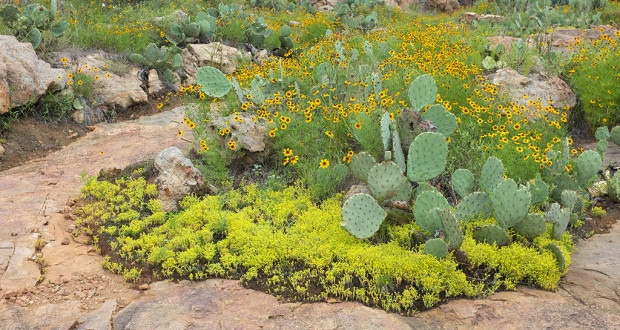A short, spectacular trail lies near the Devil’s Waterhole at the end of one arm of the lake. In spring, it is a landscaped garden, scattered with seemingly cultivated islands of wildflowers and blooming prickly pear cactus in the midst of barren orange rock. Climb to the top and the garden opens onto a canyon of bluffs and boulders surrounding a stream that trickles into the lake. The terrain below is a collection of sandbars, pools and small waterfalls, with delicate plants clinging to life in the crevices of rocks and on the edges of the stream.
The park’s interpretive guide describe the unique vegetation:
Shallow temporary rainwater basins called vernal pools form on rock outcrops. The thin layer of sand and organic material on the bottom of the pools sustains a great variety of aquatic plants which become dormant when the water dries up in summer… Some of these plants, such as rock quillwort and basin corn salad, are found only in this area of Texas, and nowhere else in the world. Dry, gravelly areas, shaded crevices and the outcrop base may support wild onions, carpets of spikemosses, sedges, native grasses, spiderworts, and several arid land fern species.
At the other end of the park, a network of trails curls around another arm of the lake and crosses the road into the hills above. The trails are marked by color – Green, Yellow, Blue and Red. They can be mixed and matched into hikes of varying lengths up to about 7.5 miles. Except for just a few areas, there is not a lot of shade. Most of the terrain consists of rocky paths and bare rock cutting through Ashe juniper, prickly pear cactus and brush. A Pecan Flats interpretive guide details much of the flora along the trails.
The Green Trail loops around a rocky knob of the lake. The Yellow Trail wanders through woodlands, streams and rocky hills. The Blue Trail is both primitive and scenic. The Red Trails, which are steep and rugged, connect the others.
PARK GALLERY








You must be logged in to post a comment.